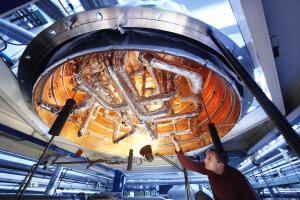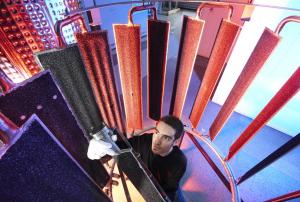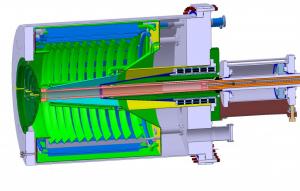Cold, cold world
Ever put your finger on the cold wall of your freezer? Then you must have noticed that it remains stuck and that it sometimes hurts to rip it free.
Atoms, molecules, particles are all captured by cold—and the more intense the cold, the more irresistible its holding power. When they come into contact with a very cold surface—say, a couple of Kelvins—even gas molecules turn solid, lose all energy and remain helplessly trapped.
This is why scientists use extreme cold to achieve extreme vacuum: a surface cooled to a very low temperature will eventually "suck in" almost every particle it comes into contact with. In a rather schematic way, this is the principle upon which cryopumps are based.
Cryopumps are essential for optimum plasma performance in ITER. They appear on the scene after mechanical pumps have evacuated most of the air molecules and impurities from the vacuum vessel, and brought the inside pressure to 1/10 000th that of the atmosphere.
The task entrusted to the eight "torus cryopumps" is to further reduce the pressure inside the vessel by another six orders of magnitude—these are conditions that one would encounter in the void of outer space.
Once a plasma has been generated, the cryopumps are back on stage: their job is now to extract the helium ash generated by the deuterium-tritium fusion reaction. "Helium particles are the most difficult to trap," explains Robert Pearce, ITER Vacuum Pumping Section Leader. "Even with surfaces at a temperature of 4.5 Kelvin (minus 268 °C) they retain enough energy to slip away."
One achieves efficient "helium pumping" by coating the cold surfaces of the cryopumps with a porous material that captures the particles in its microscopic mesh. Once caught, they do not have enough energy to escape.
A very fine carbon matrix is the best material for imprisoning helium particles. Regular charcoal was used in JET but it was later found that charcoal from finely ground coconut shells works even better—it has the right density and porosity (read article below). "We could use carbon fibre nanotubes ... but the European Union has bought enough coconuts to last us for the whole duration of ITER operation," says Robert.
Torus cryopumps will also give back part of what they have taken. Deuterium and tritium particles that have been sucked along with the helium ashes will be processed in the tritium plant and fed back to the plasma. "What is quite unique in ITER," says Robert, "is that at any one time, some of the eight torus cryopumps (typically four) will be pumping, while the others will be regenerating, thus keeping the fuel moving in a 600-second cycle."
This cycle of cooling, warming and pumping out the cryopumps is extremely challenging. "It is something that has never been done before," stresses Robert. Torus cryopumps in ITER will have to withstand some 50,000 of these cycles, with huge temperature gradients, and remain absolutely leak-tight.
In a couple of months, specialists from ITER Vacuum Pumping Section and from Forschungszentrum Karlsruhe (Germany) will have finalized the design of a real-size cryopump prototype, and tests could begin as early as a year and a half from now.
All together, the ITER torus cryopumps will deploy 88 square metres of cold surface—the equivalent of an average-size apartment.




